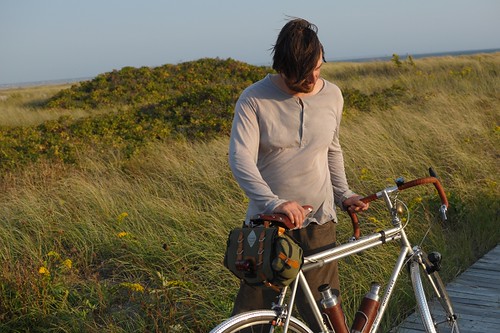 Walking into an outdoor clothing and gear retailer today, we invariably see an expanse of merchandise that is stylised to portray outdoor pursuits as highly technical activities. Fabrics of unnatural textures emitting an otherworldly sheen, colour schemes that don't exist in nature, motifs based on jarring geometric forms, aggressive logo placements - the overall feel is decidedly inorganic. And perhaps that is the key to why I find the aesthetics of today's outdoor industry so disturbing: How can clothing and gear designed for an intimate relationship with our natural surroundings be made in a way that is so at odds with them?
Walking into an outdoor clothing and gear retailer today, we invariably see an expanse of merchandise that is stylised to portray outdoor pursuits as highly technical activities. Fabrics of unnatural textures emitting an otherworldly sheen, colour schemes that don't exist in nature, motifs based on jarring geometric forms, aggressive logo placements - the overall feel is decidedly inorganic. And perhaps that is the key to why I find the aesthetics of today's outdoor industry so disturbing: How can clothing and gear designed for an intimate relationship with our natural surroundings be made in a way that is so at odds with them?As a teenager in the 1990s I noticed that it disconcerted me to go hiking and see other hikers decked out in this high-tech gear. Watching them move through the landscape, they seemed to be invading nature, not striving to be a part of it. I found myself wondering how long those garments would take to decompose once discarded after a season or two, and what effect their decomposition would have on the beautiful scenery. It particularly disturbed me that outdoor enthusiasts did not seem to be aware of this contradiction. Carrying food and drinks in a myriad of plastic containers, they tramped through meadows and forests clad in aggressively styled garments made of artificial fabrics - an alien presence in their own world.
No doubt as a direct reaction to this I found myself drawn to natural fabrics and materials in everything from clothing, to furniture, to the everyday products I used, and also drawn to aesthetics that harmonised with my surroundings. And early on I felt that content and form went hand in hand here: When a particular aesthetic style becomes popular, it informs what is socially valued. And this has a huge overall impact on what kind of things get made and on how they get made. The aggressive, sporty, techie look has grown absolutely ubiquitous in outdoor gear - so much so that wool outdoor clothing manufacturers looking to become mainstream have taken to imitating the look of artificial fabrics in order to visually convince that their product is equally functional. The fact that what makes wool functional is its natural properties is laughably lost when this tactic is employed.
But recently the outdoor industry has experienced a small but noticeable backlash against the high-tech, and this includes the realm of bicycles and bicycle-related products. The growing public awareness of fringe brands such as Rivendell Bicycle Works and Archival Clothing have made both consumers and manufacturers rethink the aesthetics of an outdoor lifestyle. Some interpret this phenomenon as nostalgia-driven, and some see it as a form of consumer elitism. But I believe there is at least some element here of a rising collective desire for products that are more harmonious with our natural surroundings. Reverting to traditional looks, fabrics and manufacturing processes is simply the byproduct when things are made in this manner. The return of the steel bicycle with the waxed canvas bag is not so much about "re-enactment" as it is about rethinking ways of being in nature.
No comments:
Post a Comment